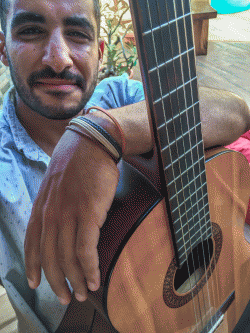Vancouver Guitar Instructor Joe

| Name | Joe H. |
| City | Vancouver, BC |
| Additional Locations | Vancouver, Vancouver | Teaching | Guitar |
| Working With | Kids, Youth, Adults, Groups |
| Levels | Beginner, Intermediate |
| Hourly Rate | $40 |
Professional classic and flamenco guitar player with over 15 years of experience and teaching experience as well
Music Background & Credentials
Didnt study music theory
Professional Experience
Played in couple of bands as backing guitarists, and i play very often in solo performances in restaurants and public venues
Teaching & Other Details
Class topics: Class #1 Physical Components of the Guitar: Covering the physical construction of the guitar, different types of guitars, how to hold a guitar and pick as well as stringing and tuning to standard E-A-D-G-B-E. Application: Basic strumming, picking, learning how to use a tuner and posture technique can be assigned as homework or for practice time. Class #2 Learning Chords, Correcting Buzzing Notes and Improving Overall Physical Technique: Cover basic open chords, usually G, C, D, E, Em, A, Am and F, while also teaching how to avoid note buzzing and using chords to strengthen your fingers and prepare them for barre chords. Application: Give the student a list of chords to play, along with some tabs that show how to break the chords out into arpeggios, and how to run scales. Instruct the student to concentrate on maintaining clear notes that don’t buzz and show them how to correct the ones that do. Class #3 Learning other types of chords: Minor, Major, Power and Barre. Discuss the difference between major and minor chords and introduce student to the basic barre chord shapes. Application: Give student some easy guitar songs and tabs that use the chords they’ve learned. By now, they have enough chords in their vocabulary to play a lot of music. Class #4 Start learning basic scales: Major and melodic minor and all four pentatonic scales can be covered in one lesson. Help the student learn both the pattern and the sounds of the scales that you’re covering, while also providing an understanding of the root note of a scale and how to move that scale on the fret board. Make sure to articulate how the single notes, chords and scales are all interconnected. Application: Illustrate how to use the scales for basic improvisation and allow the student to experiment by trying to incorporate “new notes” into the scale that aren’t listed. Class #5 Cover the basics of intervals and power chords and how you can use intervals to get more familiar with the fret board. Explain the theory behind intervals, how they can be used for chords and to understand fret board sounds. Also, cover how this can relate to improvising and playing lead guitar. Application: Take some of the scales you learned before and try to extend them by adding intervals. Use this technique to develop the student’s ability to improvise on their own. Class #6 Illustrate soloing techniques like bends, vibrato, hammer-ons and pull-offs. Cover the physical and musical aspects of these techniques and show the student how to apply them to single notes and simple melodic patterns. Also discuss how these are represented in tablature. Application: Provide a few of your own improvised tabs for the student to practice soloing techniques. Assign the student to come up with their own improvised lead piece by using a scale of their choice and at least five extended notes based on intervals. Class #7 More complex scales should be covered, while discussing the correlation between scales and improvising a little more specifically. Cover some more complex pentatonic and blues patterns and provide more theory and detail about how those scales help you improvise. Application: After memorization the student should be able to work in and out of the scale and know when they’re improvising or “extending” the scale as opposed to playing within the structure of the scale itself. Class #8 Address rhythm and song dynamics. Discuss how rhythm impacts your strumming technique, while also covering how the dynamics and intensity of a song should impact how the guitar is played. Application: Assign songs for the student to listen to that exemplify the dynamics of the guitar and help the student hear when they need to pull back or play heavier. Have the student work on their ability to play softer and louder on command by making use of effects and their own technique.
Availability
Upon request
Preferred Teaching Place
Vancouver